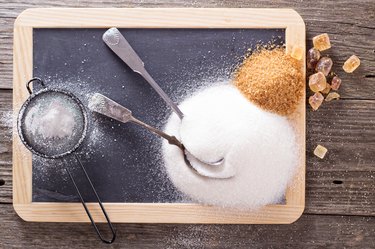
The term "sugar" is commonly associated with sweet treats or a white crystalline powder you add to foods; however, sugar is also a classification of carbohydrates. The varying chemical structures of sugar include single units called monosaccharides, double units, or disaccharides, and multiple units, which are oligosaccharides or polysaccharides. No matter the chemical structure of a sugar chain, your body digests all sugars in a one step process.
Sugar Digestion
Video of the Day
Once you swallow food, it travels down your esophagus to your stomach where digestive juices dilute it for later movement through the rest of your digestive tract. Sugar and carbohydrate sugars pass through your stomach rather quickly to begin the process of breaking down in your small intestine. All forms of sugar break down into the smallest possible sugar molecule with the help of digestive enzymes housed in the lining of your small intestine. Once sugar returns to single molecule form, or a monosaccharide, it is absorbed through the intestine into your blood as glucose. Your pancreas secretes the hormone insulin to retrieve the blood glucose and distributes it to different cells throughout your body for use as energy.
Video of the Day
Monosaccharides and Disaccharides
Fructose, dextrose and galactose are common monosaccharides found in foods like fresh fruit or milk. Sucrose, lactose and maltose are made of two monosaccharide chains, or disaccharides, like those found in table sugar, germinating grains and dairy. When you eat these types of sugar-containing foods, your digestive system breaks the saccharides down into a single molecule and converts it into glucose. The mono and disaccharide sugars breakdown and quickly get released into your bloodstream, which may cause a quick "sugar rush" followed by a crash, depending on the food source eaten. For instance, a spike and crash occurs from eating sugary candy, but if you eat a strawberry with natural sugar, your blood glucose sustains longer because the fruit also contains fiber, which slows the digestive process.
Multiple Sugar Carbohydrates
Complex carbohydrates contain multiple sugar chains including polysaccharides like starch or oligosaccharides, which are high in fiber and indigestible. When you eat wheat bread or oatmeal, the sugar in the food breaks down into a single molecule dispersed as glucose into your bloodstream, but these types of foods also contain a high amount of indigestible fiber. Essentially, the sugar is digested the same way because it is turned into a monosaccharide before conversion to glucose. However, the complex carbohydrate-containing food has additional nutrients your body uses in the digestive process.
Healthy Sugar Sources
The healthiest sugars come from complex carbohydrate-containing foods or fresh fruits and vegetables. These food sugars keep your blood glucose sustained to energize you throughout the day. The occasional sweet treat with refined sugar is fine with a well-balanced diet but gorging on junk food may leave you feeling irritated and craving more sugar-filled treats if you do not choose nutritious foods. Opt for whole grains instead of processed white grains, which generally have added sugars. Choose raw produce instead of canned or frozen varieties and limit your use of table sugar.
- National Digestive Diseases Information Clearinghouse; Your Digestive System and How It Works; April 2008
- Oklahoma State University; Carbohydrates in the Diet; Janice Hermann, PhD, RD
- Scientific Psychic; Carbohydrates Chemical Structure; Antonio Zamora; 2005
- Elmhurst College Virtual Chembook; Carbohydrates Classification; Charles E. Ophardt; 2003